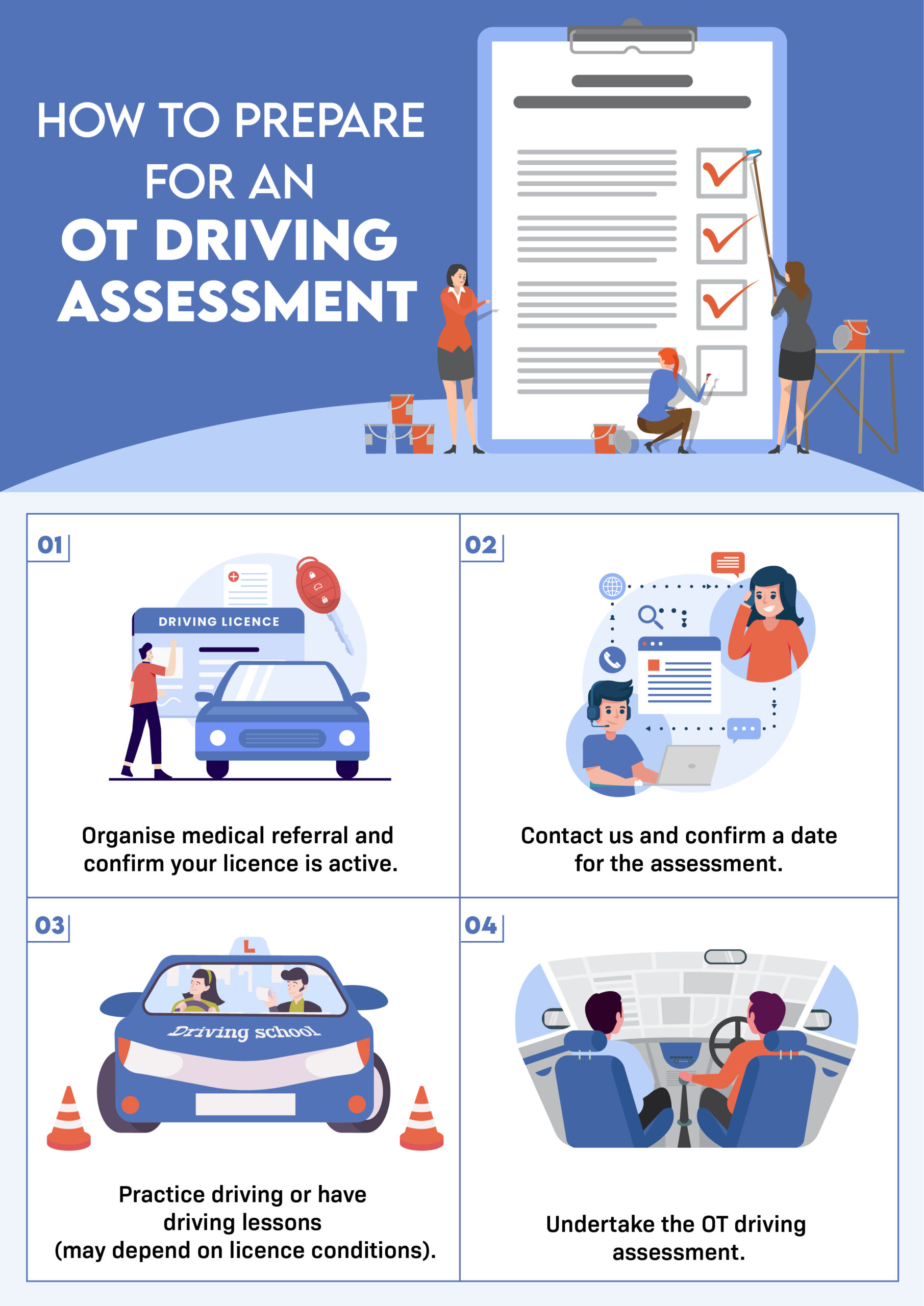Purpose of the on-road assessment
This article follows the previous article the “off-road assessment explained”. As mentioned in this preceding article, an Occupational Therapy Driving Assessment is divided into two components; the off-road and on-road components. Each section lasts 1 hour. Our previous post was about the theoretical side of the Occupational Therapy driving assessment. This article explains what is involved in the practical component of the assessment.
When a person is diagnosed with a medical condition that possibly impacts on their driving capacity, the person’s doctor does not actually observe the person driving. The most effective and thorough way to explore a person’s fitness to drive is to observe them driving, as driving is a practical activity. This is precisely what the on-road section of the Occupational Therapy driving assessment achieves. During the on-road assessment, the person is given some time to become familiar with the vehicle they will be driving. It will be an automatic or manual vehicle, according to the person’s preference and/or the vehicle they currently own. For everybody’s safety, the assessment is conducted in the driving instructor’s vehicle, which is a dual control car (where the instructor has brakes on their side). This ensures that the assessment is conducted in a safe and legal manner.

Format of the on-road assessment
Generally, there will be three people in the car for the assessment – the client, the Rehabilitation Driving Instructor and the Driver Trained Occupational Therapist. Sometimes, the person’s carer, interpreter or support person may also be present (this can be arranged prior with the OT). Typically, the assessment will commence with the person positioned in the driver’s seat, the Rehabilitation Driving Instructor in the front passenger seat, and the Occupational Therapist in the rear left passenger seat.
To allow the person some time to familiarise themself with the car, the assessment usually commences in quiet streets in residential areas with limited traffic. The person is given the opportunity to make any ergonomic adjustments to the car (e.g., adjust seating, mirrors) and become accustomed to the vehicle controls. Once the person feels more comfortable and confident operating the vehicle, the assessment will proceed to moderate and complex traffic environments. There are three categories of traffic for the assessment:
- Mild traffic: single lane roads with speed limits up to 50km/hour (typically residential areas)
- Moderate traffic: single and multi-lane roads with speed limits up to 60km/hour
- Complex traffic: single and multi-lane roads with speed limits above 70km/hour
The format of the assessment is that the driving assessment takes a pre-determined route that is typically 60 minutes in duration. The driving instructor will give instructions to the person and the person’s ability to follow directions is examined. There will also usually be a component where the person will be asked to self-direct to a familiar place (e.g., travel from local shopping centre back home). This looks at the person’s working memory. All forms of traffic are encountered during the practical assessment to certify that the person is safe to drive in varying and changing traffic situations.
This format may deviate depending on the person’s need for driving and if they hold a private or commercial driver’s licence. For example, a person with cognitive impairment may struggle when driving in unfamiliar environments and their need for driving may be to only access their local shopping centre and visit family or friends nearby. Thus, the driving assessment can be restricted to 5km from home, and this restriction would be endorsed on their licence.
Specific driving tasks assessed
During the assessment, the Occupational Therapist’s role is to find out if there are any deficits related to the person’s medical condition that are affecting their driving capacity. To make this determination, the assessment must encounter specific driving conditions and situations, where the person is asked to complete various driving manoeuvres. The assessment encounters the following driving conditions:
- Varying speed limits
- Lane changes on multilane roads
- Traffic lights
- Controlled and uncontrolled intersections
- Shared driving areas
- Use of indicators
- Cornering
- Breaks, accelerator and steering wheel control
- Stop and give way signs
- Entering and exiting the kerb
- Blind sport and mirror checks
- Roundabouts
- Hazard identification and response
During the assessment, the Occupational Therapist assesses if the person’s medical condition impacts on their ability to perform any of these tasks. As well as the person’s ability to follow road rules, traffic laws and instructions from the driving instructor, crucial skills necessary for driving are also inspected. These include assessing memory and recall, divided attention (being able to do several tasks at once), coordination, processing speed and decision-making, spatial awareness. Driving is a complicated task that involves smooth organisation and coordination of visual, physical and cognitive capacities. The effect of the person’s medical condition on these abilities is the prime focus of the assessment.
If the person makes what is deemed a critical error, a ‘fail’ of the assessment will be the outcome. A critical error is defined as any error where the driving instructor is required to physically intervene to prevent a collision or accident. This involves either activation of the dual control brake or the driving instructor taking control of the steering wheel. It is important to note that the driving instructor will allow and encourage the person to drive and will only physically interfere if the person has failed to respond to a situation and an accident is imminent. Examples of critical errors are if a person fails to follow road signs (e.g., stop at a ‘stop’ sign) or commences a turn when it is unsafe to do so. If the person commits nil critical errors in the assessment, they will most likely achieve a favourable outcome and ‘pass’ the assessment.
It is also common for people to become nervous when under testing conditions. This is taken into account and any minor errors due to this will not usually cause a negative outcome for the assessment. Similarly, minor errors that are related to the person being unfamiliar with the vehicle or poor driving habits (e.g., forgetting to activate vehicle indicators when no other vehicles are nearby) is not likely to lead to a ‘fail’ of the assessment. As noted previously, as long as the driving instructor is not forced to physically intervene, an error will not be regarded as critical in nature. For people with physical conditions and disabilities that require vehicle modifications to drive safely, a dual control vehicle with the appropriate modifications will be organised.
On-road driving assessment
After the assessment
After the on-road assessment, the Occupational Therapist will consult with the driving instructor and render an outcome, then discuss the results of the assessment with the person. The Occupational Therapist will explain what the person will need to do next (e.g., directions from the RMS). There are several potential outcomes of a driving assessment that range from pass, fail or the recommendation of a driving rehabilitation lesson plan. These outcomes will be covered in a later article.





